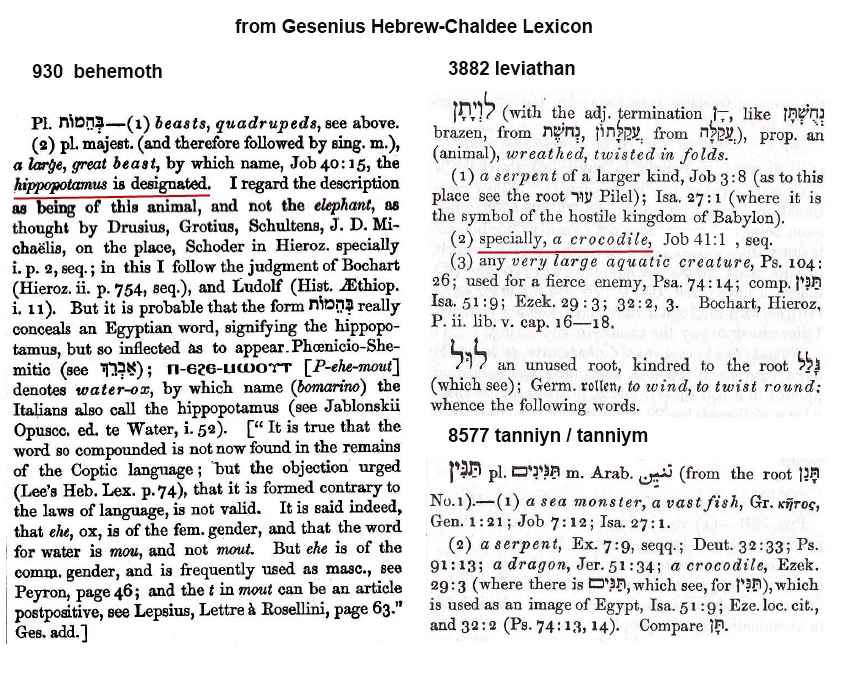Bible Dragons!
Dragons! You have got to be kidding! No one believes in Dragons!
How can we have a serious discussion about Dragons?
But, to the citizens of Great Britain at the time that the King James Version of the Bible was being translated dragons were a serious topic! One author in doing his research located nearly 200 places in the area at which "dragon" sightings had been reported. The literature of the day contained many references to dragons and similar creatures.
In the King James Version of the Bible the Hebrew words that are translated most often as dragon/dragons was "tanniym/tanniyn". Fig 1 below details the places in the Scriptures where it occurs and how it is translated by the King James Version, the New King James Version and other varying translations given by various Bible versions.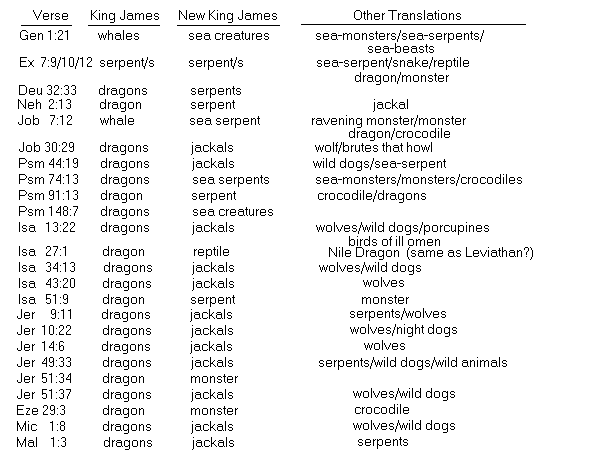 Fig1
Fig1As you can see the more modern version of the Bible, the New King James Version, has most utilized jackals when the context indicates that a wild desert animal is indicated and this obviously makes sense considering the wild and desert environment of the Biblical area at the time. However, there are a number of other passages when obviously a sea animal is indicated and where the characteristics are such that a much larger and terrible animal are indicated. In those cases they used monster, sea creature or serpent. From reading Isaiah 27:1 it seems obvious that "tanniym/tanniyn" also includes the leviathan of Job 41, which is also mentioned in Psalms 74:14 and 104:26. We obviously conclude that it can also include the behemoth of Job 40:15.
Leviathan, a mighty sea creature with scales and terrible teeth. Arrows, swords, stones and javelins cannot harm him and he regards iron as straw. A flame goes out of his mouth and smoke out of his nostrils. He makes the sea boil and leaves a shimmering wake. His heart is hard as stone and when he rises up the mighty become afraid. Sounds like the classic dragon from the dark ages, does it not? However, the crocodile is the most likely candidate, as we will discuss below.
Behemoth, he eats grass, his bones are like beams, his ribs like bars of iron, he has power and strength in his hips and stomach muscles. His tail like a cedar is one characteristic that has bothered many since some have proposed the hippopotamus which has a small elephant type tail. Some have proposed the crocodile which has a strong tail, but they are not known for eating grass. Therefore, some have proposed that the behemoth is unlike any animal now living. It must have been one of the animals now extinct? However, the hippopotamus is the most likely candidate.
Gen 1:21 So God created the great sea creatures ... (ESV)Job 40:15 "Behold, Behemoth, which I made as I made you; (ESV)
Since the 12 animals in Job 38:39-39:30 were real animals of the time it is reasonable to believe that both the Behemoth and Leviathan as revealed in Job 40 and 41 were also real living animals at that time. The totally practical nature of the book of Job in discussing real human suffering also reinforces this belief.
The power of the hippopotamus instilled a fear in Egyptians which led to a worship and a respect of the animal with whom they were forced to share territory. Thus, the hippopotamus became a central figure in Egyptian art and religion. "In Egypt the Pharaoh, in preparation for his enthronement, ritually harpooned (with the help of others) a male hippopotamus and occasionally a crocodile, to dramatize his ability to dispel chaos and maintain order. The king could carry out this difficult harpooning task only because of his supposed superhuman, god like strength. But God was showing Job that he did not have the ability. Since he could not conquer the animalistic symbols of evil, how could he subdue evil people ?" ( from "The Bible Knowledge Commentary" Victor Books, 1985 page 771)
Therefore, as many scholars have concluded, the two most likely candidates are the hippopotamus for Behemoth and the crocodile for Leviathan !! (see Appendix B)
One of the most often proposed difficulties for the Behemoth is with Job 40:17 "He moveth his tail like a cedar:". Many say this has to be one of the many extinct dinosaur species that had very large tails.
” The Hebrew word (#2654 chaphets) means “to bend, to curve;” and hence, it commonly denotes “to be inclined, favorably disposed to desire or please.” The obvious meaning here is, that this animal had some remarkable power of “bending” or “curving” its tail, and that there was some resemblance in this to the motion of the cedar-tree when moved by the wind. In “what” this resemblance consisted, or how this was a proof of its power, it is not quite easy to determine. Rosenmuller says that the meaning is, that the tail of the hippopotamus was “smooth, round, thick, and firm,” and in this respect resembled the cedar. The tail is short - being, according to Abdollatiph (see Ros.), about half a cubit in length. In the lower part, says he, it is thick, “equaling the extremities of the fingers;” and the idea here, according to this, is, that this short, thick, and apparently firm tail, was bent over by the will of the animal as the wind bends the branches of the cedar. The point of comparison is not the “length,” but the fact of its being easily bent over or curved at the pleasure of the animal." (Albert Barnes "Notes on the Bible")
The Hippo's tail, while not very large, it has the remarkable ability to rapidly wag back and forth and fling its dung.
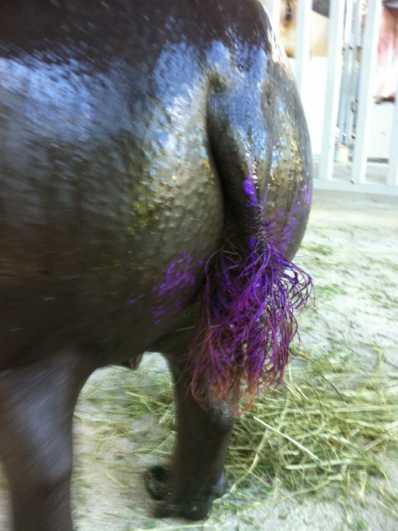

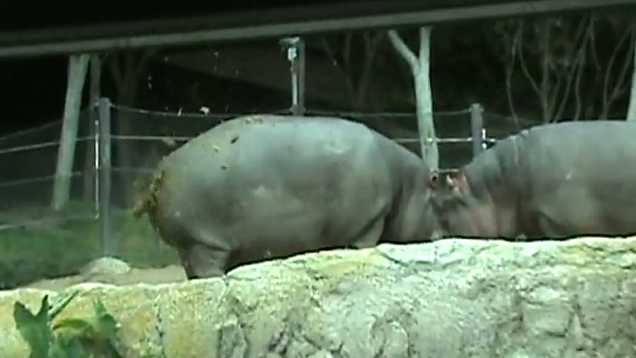
see video at http://www.youtube.com/watch?v=hy8nDb5nCak&feature=related
The word "Leviathan" comes from the Hebrew word meaning "one who twist and coils," or "the winding one" which so well fits the crocodile since they consume food that can not be eaten in one bite by biting and then spinning or convulsing wildly until bite-size chunks are torn off. This is referred to as a "death roll." Critical to the alligator's ability to initiate a death roll, the tail must flex to a significant angle relative to its body. An alligator with an immobilized tail cannot perform a death roll.
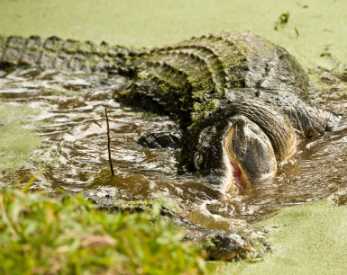
see video at http://www.youtube.com/watch?v=A0tXM5fSFrw
Conclusion: Behemoth is the hippo and Leviathan is the crocodile.
For a longer detailed discussion by Albert Barnes see
http://www.sacred-texts.com/bib/cmt/barnes/job040.htm
starting with 40:15 and http://www.sacred-texts.com/bib/cmt/barnes/job041.htm
Appendix A
from http://www.bible-history.com/isbe/D/DRAGON/" DRAGON drag'-un (tannin, plural tannim, tannoth; drakon):
Tannin and the plural tanninim occur 14 t, and in English Versions of the Bible are variously rendered "dragon," "whale," "serpent" or "sea-monster"; but Lam 4:3, the King James Version "sea-monster," the King James Version margin"sea calves," the Revised Version (British and American) "jackals." Tannim occurs 12 times, and is rendered "dragons," the Revised Version (British and American) "jackals," except in Ezek 29:3, where the King James Version has "dragon" (the American Standard Revised Version "monster"), and in Ezek 32:2, where the King James Version has "whale" and the English Revised Version and the King James Version margin"dragon" (the American Standard Revised Version "monster"). Tannoth occurs once, in Mal 1:3, where it is rendered "dragons," the Revised Version (British and American) "jackals." Drakon occurs 12 times in Rev 12; 13; 16; and 20, where it is uniformly rendered "dragon." (Compare Arabic tinnin, the constellation, Draco.) Tannoth Septuagint domata, "dwellings") is a feminine plural form as if from tannah, but it suits the context to give it the same meaning as tannim.
In Ex 7:9,10,12, tannin is used of the serpents which were produced from Aaron's rod and the rods of the Egyptian magicians, whereas in Ex 4:3 and 7:15, for the serpent produced from Aaron's rod, we find nachash, the ordinary word for serpent. In two passages we find "whale," the Revised Version (British and American) "sea-monster"; Gen 1:21: "And God created the great sea-monsters, and every living creature that moveth"; Job 7:12: "Am I a sea, or a sea-monster, that thou settest a watch over me?" Other passages (the English Revised Version and the King James Version) are Dt 32:33: "Their wine is the poison of dragons (the American Standard Revised Version "serpents"), and the cruel venom of asps"; Neh 2:13: "And I went out by night by the valley gate, even toward the dragon's (the American Standard Revised Version "jackal's") well" (the King James Version "dragon well"); Ps 91:13: "Thou shalt tread upon the lion and adder: the young lion and the serpent (the King James Version "dragon") shalt thou trample under foot "; Ps 148:7: "Praise Yahweh from the earth, ye sea-monsters (the King James Version "dragons"), and all deeps"; Jer 51:34: "Nebuchadrezzar the king of Babylon hath devoured me, .... like a monster" (the King James Version "dragon"). Here also two tannim passages; Ezek 29:3: "Thus saith the Lord Yahweh: Behold, I am against thee, Pharaoh king of Egypt, the great monster (the King James Version "dragon") that lieth in the midst of his rivers, that hath said, My river is mine own, and I have made it for myself"; and Ezek 32:2: "Son of man, take up a lamentation over Pharaoh king of Egypt, and say unto him, Thou wast likened unto a young lion of the nations: yet art thou as a monster (the English Revised Version "dragon," the King James Version "whale") in the seas; and thou didst break forth with thy rivers and troubledst the waters with thy feet, and fouledst their rivers."
The foregoing passages offer no especial difficulties in the interpretation of the word tannin. All may fairly be understood to refer to a serpent or sea-monster or some imaginary creature, without invoking any ancient myths for their elucidation. The same may be said of the passages in Revelation. A dragon is taken as the personification of Satan, as of Pharaoh in the passages in Ezekiel. It is of course true that ancient myths may more or less distantly underlie some of these dragon and serpent references, and such myths may be demonstrated to throw additional light in certain cases, but at least the passages in question are intelligible without recourse to the myths. This however is not equally true of all the tannin passages. In Ps 74:12 we read: "Yet God is my King of old, working salvation in the midst of the earth. Thou didst divide the sea by thy strength: thou brakest the heads of the sea-monsters (the King James Version "dragons") in the waters." Compare Isa 27:1; 51:9 f.
The three passages just cited seem to denote each some particular act, and are referred by Canon Cheyne (Encyclopedia Biblica, under the word "Dragon") to the old Babylonian myth of the conflict of Marduk and Tiamat in the Assyrian creation-legend (thus Gunkel, etc.). Indeed he refers to that myth not only these passages, but also Jer 5:34; Ezek 29:3-6; 32:2-8 and Job 7:12, which have been cited above. In translating the last two passages, Canon Cheyne uses the definite article, "the dragon," instead of "a" as in the Revised Version (British and American), which makes a great difference in the meaning. In Ps 87:4, it is clear that Rahab is a country, i.e. Egypt. Isa 30:7 is to the same point. In Isa 51:9,10, "that didst cut Rahab in pieces" and "that didst pierce the monster" (the King James Version "dragon"), are two coordinate expressions of one idea, which is apparently the defeat of the Egyptians, as appears in the reference to the passage of the Red Sea. In Isa 27:1, "leviathan the swift serpent" and "leviathan the crooked serpent" and "the monster (the King James Version and the English Revised Version "dragon") that is in the sea" have been identified with Babylon, Persia and Egypt (Encyclopedia Biblica, under the word "Dragon," 4). It is more probable that the first two expressions are coordinate, and amount to "leviathan the swift and crooked serpent," and that the verse may therefore refer to Babylonia and Egypt. Ps 74:12-15 is more in line with the idea of the article in EB, but it is nevertheless susceptible of an explanation similar to that of the other two passages.
Tannim, "dragons" (the Revised Version (British and American) "jackals") occurs in Job 30:29; Ps 44:19; Isa 13:22; 34:13; 35:7; 43:20; Jer 9:11; 10:22; 14:6; 49:33; 51:37; tannoth, "dragons" (the Revised Version (British and American) "jackals") is found in Mal 1:3. In all these passages, "jackal" suits the context better than "dragon," "sea-monster" or "serpent." An exception to the rendering of "dragon" or "serpent" or "sea-monster" for tannin is found in Lam 4:3: "Even the jackals draw out the breast, they give suck to their young ones." the King James Version has "seamonster," the King James Version margin"sea calves." A mammal is indicated, and the Revised Version (British and American) apparently assumes that tannin is an error for tannim. Two other exceptions are in Ezek 29:3 and 32:2, where English Versions of the Bible renders tannim by "dragon," since in these two passages "jackal" obviously will not suit.
Alfred Ely Day
Bibliography Information
Orr, James, M.A., D.D. General Editor. "Definition for 'DRAGON'". "International Standard Bible Encyclopedia". bible-history.com - ISBE; 1915.
Copyright Information
© International Standard Bible Encyclopedia (ISBE) "
